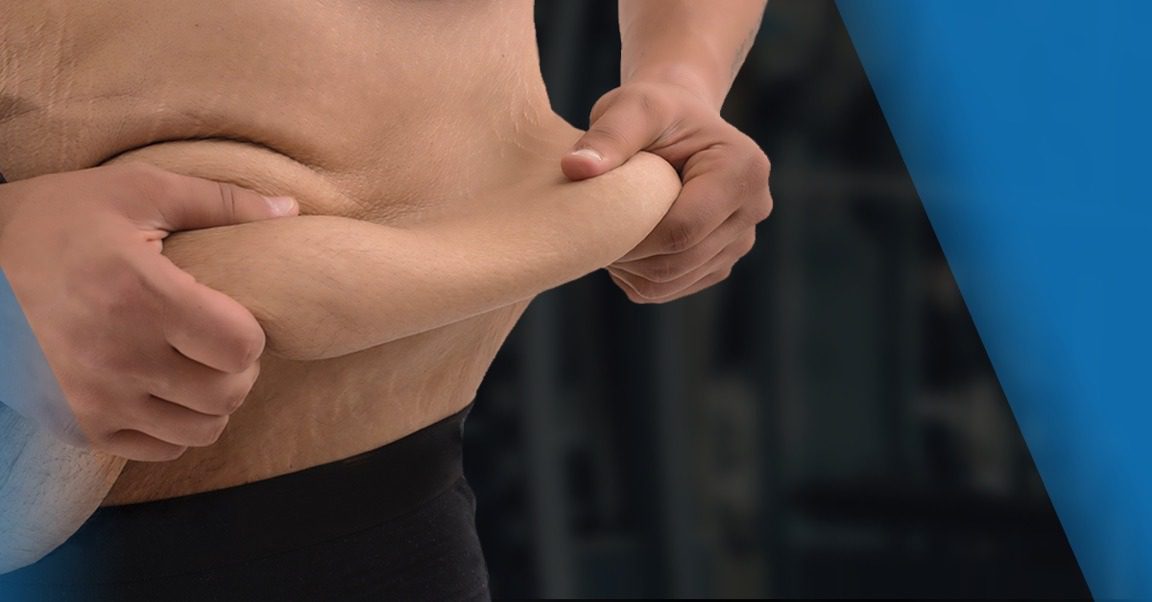I work with a lot of clients who’ve lost a lot of weight following bariatric surgery. While the health benefits are undeniable, extreme weight loss has one brutal side effect: excess skin.
Imagine the problems it creates. Start with the fact that it’s unsightly, and consider what it’s like for someone who’s lost 100 or 200 pounds and is still too embarrassed to wear a swimsuit in public.
But it gets worse. A pannus, the excess skin from the abdomen that drapes over the crotch, can be a foot long and weigh 50 pounds or more. Imagine having to move that out of the way every time you use the toilet, or how it interferes with intimacy.
And it gets still worse from there. That loose skin will chafe easily, leading to rashes and infections that not only hurt, but smell.
Unless you’ve been there, it’s hard to wrap your mind around the inconvenience, embarrassment, and physical pain that often results from successful weight loss.
Now imagine that it’s one of your clients. You’ve helped her lose the weight, and she asks you what to do about this unfortunate side effect.
What do you say? Is there a training method to target loose skin? Can you tweak the diet? Recommend a supplement, or a skin treatment?
Unless you’ve done the research, or worked with a lot of these clients, you probably have no idea. And that’s fine; you don’t need a background in dermatology to be a good trainer. So let’s dive in, starting with the most obvious part of the problem: the skin itself.
Beyond the Breaking Point
Skin is a remarkably versatile organ. It protects everything it covers, helps regulate body temperature, and makes you look like you. Most of the time, it’s a perfect fit. You can gain or lose a few pounds and your skin stretches or contracts accordingly.
Two types of fibers make this possible: elastin and collagen.
Elastin fibers act as little rubber bands, allowing skin to stretch and relax without losing its original tension. Collagen fibers are like little guy wires that provide structural support. Damage to either type of fiber will change the skin’s appearance.
Take pregnancy, for example. In the final 10 weeks alone, the mom’s abdominal circumference will increase by an inch a week. That’s a lot of damage to those elastin and collagen fibers, and many women will have stretch marks long after giving birth (not to mention insane grocery bills for the next 18 years).
Such tiny fibers can only stretch so far. When tension threatens to exceed the skin’s tolerance for it, your body will manufacture more skin cells in that area. Thus, by the time the baby is born, a new mom will have some skin that wasn’t there before. (Surgeons sometimes use this mechanism to grow new skin for people who need a graft. They’ll expand skin in one area until it’s forced to make new tissue, then harvest that tissue for the transplant.)
But when someone gains a lot of weight over years, the body responds by adding a lot of new skin. Some of the tissue will disappear when that person loses weight, as it does after childbirth. Four factors affect how much excess skin someone will have after drastic weight loss.
1. Age
The older we are, the saggier our skin gets. Sorry, that’s just how it is. Like all our cells, elastin and collagen accumulate wear and tear, and they can’t keep skin as tight as it once was. Thus, the older the client is when she loses weight, the more likely she is to have excess skin.
2. Amount of weight lost
The skin of somebody who weighs 400 pounds is going to be a lot more stretched out than the skin of someone who weighs 280, with proportionally greater damage to the elastin and collagen.
3. Time spent stretched
Let’s return to the pregnancy example for a moment. Imagine if your postpartum client had been pregnant for nine years, instead of nine months. Her skin would be far more damaged, and she’d have a lot more of it, than if she’d experienced the normal gestation period. So it is with extreme obesity. Someone who’s carried hundreds of unwanted pounds for 25 years will have a bigger problem with excess skin than someone who only recently gained all their weight.
4. Smoking
One of the many ways smoking harms us is by making skin age faster. So if a client has a history of smoking before weight loss, he’s more likely to have excess skin afterwards.
Another question that comes up: Is there less skin left over if your client loses weight slowly? It makes sense in theory, in that the skin would have more time to adapt. Although we don’t have a lot of research, the speed of weight loss doesn’t seem to matter. Once the damage is done, loose skin will remain.
What Doesn’t Work
That brings us back to you, and what you can do for a client with prodigious amounts of loose skin.
Your first thought is probably something like this: “He just needs to fill all that skin with muscle!”
While hypertrophy is great for health and function, there’s zero chance it will fill all or even most of the space. Remember how big that part of the body was before weight loss? That’s how much muscle your client would need to build.
And consider how much food you'd need to build that much muscle mass. For someone who’s just had bariatric surgery to make her stomach smaller, that’s not even an option. She may struggle just to eat enough for basic nourishment. Slamming a protein shake after every workout might be physically impossible.
Consider, too, the message you’d send by encouraging a client who’s just lost a hundred or more pounds, with or without surgery, to eat that much food. You’re saying, in effect, “Congratulations on your weight loss. Now let’s see how fast we can gain it back!”
You’re left with two choices: change the clothing, or change the skin.
The first one is fast and relatively easy, and offers immediate benefits. Compression garments, worn beneath their clothes, hold everything in place. They can use Under Armor-style tank tops, compression shorts, Spanx, or some combination. As long as they’re extremely tight, they’ll accomplish two goals, one functional and the other aesthetic:
- Minimize movement of the excess skin, making exercise less awkward
- Lift the skin to create a more natural appearance
But you can also see the downside: It’s an extra layer of clothing, which would be uncomfortable on a mild day and miserable in summer heat. Even without compression gear, these post-weight-loss clients will often wear long sleeves and pants year-round to keep others from seeing all that loose skin.
Personally, it breaks my heart to see them when I know they’re doing it, but I can’t argue with the choice.
And that brings us to the second option: changing the skin.
The Surgical Solution
With body contouring, a surgeon cuts off the extra skin around the trunk, creating a more natural shape and appearance. It leaves a scar—potentially a massive one, if the surgeon removes a pannus—but one that can be strategically placed beneath the underwear line. That way someone who’s lost all that weight can actually enjoy his downsized life.
Same with surgeries that remove the skin around the arms, chest, or glutes; a skilled surgeon can minimize the visibility of the scars while maximizing the functional benefits: fewer rashes and infections; less chafing; more mobility; less embarrassment.
Studies routinely show that people who undergo bod con after massive weight loss report improved body image, self-esteem, and quality of life. No surprise that three-quarters of post-bariatric-surgery patients tell researchers they want the surgery, especially those who’re younger, have lost more weight, and have lost it more recently.
But—and there’s always a “but” when we’re talking about extreme weight loss—only a small percentage of them actually get the surgery.
Mostly, it comes down to money.
Plastic surgery to remove excess skin is rarely covered by insurance. Removal of a pannus, with a sticker price around $10,000, is sometimes covered. Everything else—like an arm lift (brachioplasty), which costs about $4,200—has to come out of pocket.
This follows the cost of bariatric surgery, which retails for around $23,000. About 80 percent of patients pay with private insurance, while 6 percent pay out of pocket. (The remaining 14 percent use Medicaid or Medicare.) But even with private insurance, as most of us know, a patient can still be on the hook for thousands in deductibles and copays.
So it’s rare that one of your clients can afford to pay for body contouring, on top of what he may have paid for bariatric surgery, on top of what he pays you to train him.
So What Can You Actually Do?
Your first obligation is to tell your client the truth: The more weight she loses, the more excess skin she’s likely to have. There’s no workout, diet, supplement, or skin treatment that will change this basic fact.
(Although, by pure luck, some manage to avoid the problem. The most famous example is Celesta Geyer, a former circus fat woman who lost more than 400 pounds in the mid-20th century, and looked as if she’d never been overweight to begin with.)
You can recommend compression clothing for immediate comfort and function, but for a permanent solution, the best option is body-contouring surgery. It’s not your job to give medical advice, and you have to hope the client’s doctor has already mentioned it. But if your client asks, that’s the only responsible answer.
While the client ponders it, do what you always do: Give that client her money’s worth with the best training program possible.










